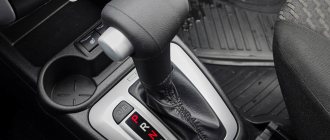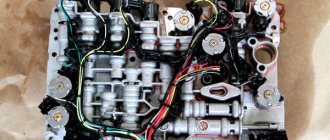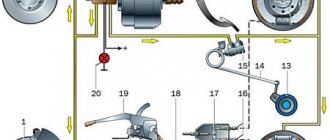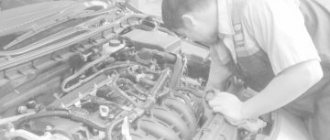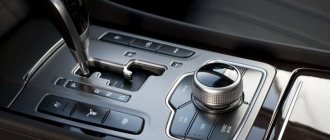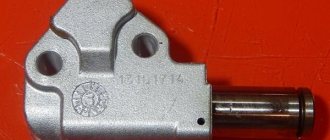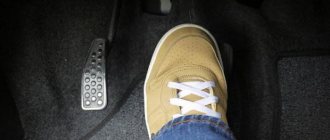Many drivers have had to deal in practice with such an incomprehensible and unpleasant situation when the automatic transmission of a car suddenly begins to act up, to function not as usual, but with obvious deviations from the norm. When it is switched, shocks appear; often, for no apparent reason, the automatic transmission “kicks” when braking or starting to move from a standstill.
Eliminating problems with automatic transmission when braking.
What to do when the automatic transmission “kicks” when braking
Many drivers have had to deal in practice with such an incomprehensible and unpleasant situation when the automatic transmission of a car suddenly begins to act up, to function not as usual, but with obvious deviations from the norm.
When it is switched, shocks appear; often, for no apparent reason, the automatic transmission “kicks” when braking or starting to move from a standstill. Eliminating problems with automatic transmission when braking.
Friction discs
Well, if we’re already talking about clutches, then we need to continue talking about them. This is a kind of clutch in an automatic machine; they either compress (stopping one or another gear inside) or unclench - putting the desired one into motion. As I wrote above, when the oil pressure drops, the clutches cannot compress effectively, they begin to slip against each other, and simply burn. This causes the oil to turn black and smell burnt. If the friction discs are worn out (or burned out), then the gears cannot stop or start at the right time. This way, when you shift, you will feel like your transmission is jerking or kicking.
It’s not uncommon that the gears may not engage at all, or when the car is put in neutral, the car continues to move, this tells us that the discs are stuck together and need to be replaced.
Guys, this breakdown is much more serious than the first two; you need to disassemble the automatic transmission and repair it thoroughly.
Why does the machine twitch?
An emergency situation, when the car’s automatic transmission “kicked” and twitched unpleasantly, is familiar to many. In such cases, some drivers, without delving into the reasons for what was happening, turned for help to service centers or to familiar professional automotive mechanics, who began to troubleshoot problems, often completely rebuilding the box, thoroughly changing one of the main blocks or even several of them . This method of adjusting an automatic transmission, of course, also has a right to life, however, it would be much more logical if the driver himself thoroughly understood the reasons for what happened in order to understand in the future what is happening.
Often it’s not that difficult to figure out. In modern cars with an automatic transmission, kicking is often caused by turning on the “Drive” mode. This problem can often be resolved by simply changing the oil in the transmission, after which the unwanted shocks will completely disappear. However, this does not always happen; sometimes even after a complete change of oil and filter element, no positive changes will occur, the shocks remain. Then the car owner will have to resort to full diagnostics in order to accurately find out the real cause and then eliminate it.
Automatic transmission diagnostic methods
Many years of practice have made it possible to develop a clear and effective method for diagnosing a car’s automatic transmission in case of any malfunctions, even when the automatic transmission is pushed. This technique is identical for cars of any brand that has it, regardless of the manufacturer, and involves a set of verification actions. These include a thorough check:
In addition, two tests are practiced: on a stopped car and while it is moving. When diagnosing, it is very important to clearly establish at what point in the functioning of the automatic transmission the interruptions begin. There can be several of them: when the car is just starting to move, or when it smoothly picks up speed, when it accelerates or brakes sharply, in which gear - low or high - this deviation from the norm is recorded, what engine crankshaft speed is low or high.
This comprehensive algorithm will allow you to eliminate the causes of automatic transmission failure step by step until the key reason why the machine constantly twitches becomes clear. This can happen, for example, when the internal combustion engine cushion is torn, when the chassis “acquires” play, the power unit cushion is worn out, the fluid level is excessive, dirt has accumulated inside the mechanism, etc.
What to do if the reason is ATF
The following logical algorithm suggests itself: having detected the automatic transmission twitching when switching, the first step should be to check the fluid level. It should definitely be brought back to normal by adding the required amount or, if there is excess, draining the excess. Then check the fluid for cleanliness. If signs of contamination are found, replace it. It will also be necessary to change the filter, remove deposits from the filter mesh, etc. We must not forget that the box certainly requires that it be warmed up at a low temperature before starting to move.
Calipers and bearings
Worn-out calipers are a sad matter: there is only one option: replacement. The same can be said about wheel bearings: the most reliable option to eliminate their play is to purchase and install new elements. But it’s still worth checking them first. Place the car on a jack, remove the wheel and rock the brake disc in different directions. If no play is detected, there is no need to calm down: inspect the bearing, make sure that it has lubricant. If there is even a slight suspicion of a defect, contact the nearest car service: replacing parts requires the use of special devices: pullers, etc., as well as experience.
When the box has nothing to do with it
It should be noted that the reason why a car suddenly starts to twitch strangely when starting to move, braking or accelerating for no reason at all is not always the automatic transmission. There are cases when this occurs due to the influence of low-quality fuel or interruptions in the ignition system. Since the car is one system unit, a malfunction in the operation of the engine or ignition automatically leads to deviations in the functioning of the automatic transmission. Then car diagnostics are also inevitable.
The driver should make it an ironclad rule to follow technical recommendations and preventive measures that will make it impossible or, in the extreme case, delay as long as possible a malfunction in the operation of the vehicle. This is, first of all, filling the engine with only the high-quality oil recommended by the manufacturer. In addition, strict adherence to the interval for replacing filters and fluid and, as already noted, warming up the automatic transmission when using the car at low temperatures are mandatory. Of course, you also need to operate your car carefully and from time to time have it undergo a full technical inspection, using the services of reputable service centers and good diagnosticians.
Source
Reasons for a “kicking” machine
The automatic transmission often beats when mode D is turned on; a similar defect can occur in both a warm and cold car. In two such cases there are many reasons and they are all different.
1. First of all, change the oil and filter in the gearbox. Such measures often completely or partially eliminate the problem.
2. If the automatic transmission continues to kick, then it is necessary to carry out a full diagnosis. To do this, you need to visit a specialized technical center.
3. If the box starts to kick when the engine is warm, then most likely the hydraulic plate has worn out. This means that the transformer blocking does not work.
Most often, the automatic jerks when the reverse gear is engaged. And here there are many reasons at once. It’s trite, perhaps the sensor, which changes in half an hour, does not work. The problem may also be mechanical damage. As a rule, changing the oil and filter helps in this case.
There are times when the automatic transmission jerks when switching from one speed to the next, these tips can help:
1. Change the oil, and change it to the original one. Rinse the pan and replace the filter.
Causes of shocks when shifting gears
It happens that shocks appear when switching to a lower or higher speed. Let's look at the causes and solutions to the problem.
Insufficient fluid level in transmission
Lack of lubrication will lead to incorrect operation of the unit as a whole. If it becomes more difficult to switch gears from first to second or third, you need to diagnose the oil level.
It is important to consider one point. When adding oil to the transmission, you can only use the fluid that is already in the transmission.
If the lubricants are different in composition, this can lead to their mixing and loss of properties. As a result, a complete replacement of the substance will be required. It is necessary to diagnose the lubricant level in the transmission and make sure that the cause of the shortage is not related to its leakage. This problem can occur when the seals or sealing elements wear out. You will need to drain all the oil from the system and then refill it.
A detailed video on the topic of eliminating transmission fluid leaks using the example of a Mercedes car is presented below (the material was filmed by user StaniSlav B.).
Dirty transmission oil
Contaminated fluid in the gearbox often causes jolts and kicks. Deposits usually form as a result of mixing different oils or when using the same lubricant for a long time.
This type of problem can be eliminated by thoroughly cleaning the gearbox. For this purpose, special flushing oil is used. Depending on the amount of dirt in the system, this process may need to be performed several times. You need to do the following:
- Warm up the engine to operating temperature.
- Place an old bucket or cut-off bottle under the transmission. The container will be used to collect used lubricant.
- Unscrew the drain plug or bolts on the oil pan, wait until all the fluid comes out of the system, and screw it back.
- Having previously read the instructions on the packaging label, fill the gearbox with flushing oil in the required volume. Turn on the engine and perform a test drive.
- Drain the lubricant from the system again and check its quality. If necessary, clean the unit again.
- Add new oil to the box.
Detailed instructions for cleaning an automatic transmission yourself using the example of a Mercedes Vito are presented by the Secret Garage channel.
Insufficient heating of the transmission fluid
The reason why the automatic transmission kicks when hot may be due to insufficient heating of the lubricant. Because the fluid temperature is too low, the main components of the transmission unit cannot heat up. This contributes to the formation of tremors.
“Automatic” kicks: what does it mean?
An automatic transmission is a complex unit consisting of a large number of mechanisms. Structurally, this transmission is not similar to a manual transmission, a variator, and even more so to a “robot”. This is a separate, independent unit with its own characteristics. “Automatic” makes the process of driving a car as simple as possible, but requires increased attention. Repairing an automatic transmission is much more difficult and financially more expensive than repairing a manual transmission. This is probably the only factor that repels potential buyers of cars with automatic transmission. Also, the “automatic machine” needs special care. If the driver does not monitor the condition of the transmission oil, he is guaranteed to encounter problems with the operation of the gearbox.
Various breakdowns of the automatic transmission seriously impair comfort or even prevent further operation of the vehicle. Typically, the car signals transmission malfunctions with jerks and jolts; less often, slipping occurs or one of the gears does not engage at all. Drivers often notice automatic transmission kicks, which in practice look like this:
There can be several options for a breakdown: the box kicks only when “cold” or only when “hot”. All this indicates a problem. You should immediately go for a diagnosis, without waiting for the situation to worsen. Delay in this case can cost serious repair costs in the future. Only a competent specialist is able to determine the exact cause of a malfunctioning automatic transmission based on direct signs.
Diagnostics and solutions
You can diagnose why the automatic transmission jerks when shifting using several methods:
The automatic transmission test did not show any faults in it, but the box continues to jerk; you should check how the engine operates at high and low speeds. The motor components may be faulty.
Checking the automatic transmission shows that errors have been detected in the machine, then the following instructions will help the car owner correct them.
Jerks when accelerating
When moving forward, when the car picks up speed, the automatic transmission may jerk due to problems with mechanical components.
Kicks hot or cold
The machine twitches when accelerating, and also twitches slightly when starting cold or hot, when:
Vibration when rear is engaged
Sometimes the box jerks when you engage reverse gear. You will need to test the automatic transmission using a computer.
Shocks when switching
The automatic transmission jerks when the driver moves the gear shifter to position “d” in cases where:
When the car slows down, the automatic transmission jerks due to faulty solenoids. Details in the next block.
Substandard or worn brake pads
Such pads have a variable coefficient of friction. As a result, the friction lining either works decently, then burns or melts - and then the friction coefficient drops. The alternation of such processes leads to jerks. Well, if the pads are worn down to metal, then jerking begins when the cast-iron disc is scuffed by the steel base of the pad. The pads should be replaced immediately, and if the discs are damaged, they will have to be sharpened or replaced.
The brake pads may look fine, but if you notice jerking after installing them, you need to take action.
The brake pads may look fine, but if you notice jerking after installing them, you need to take action.
What to do if the automatic transmission kicks?
A typical cause of jerking is dirty transmission oil. Over time, it becomes saturated with impurities and small metal elements, which significantly deteriorates its quality and leads to inadequate functioning of the system. Everything is simple here: the oil needs to be changed, and after that the automatic transmission needs to be washed thoroughly. It is better to do this using a washing machine. In the future, it is worth changing the oil on time.
If the root of the problem is a malfunction of the friction discs, it is better to replace them, which will require a complete disassembly of the automatic transmission. It is not so easy to perform this procedure manually.
If the shocks occur due to insufficient heating of the transmission fluid, this is a seasonal problem. With the onset of warmth it will disappear by itself. But still, you should not abuse driving with an unheated system, as this can lead to wear of the components.
Problems with faulty wiring are solved by eliminating breaks, if any, or cleaning oxidized contacts. If a fault is detected in the step-down resistor, it should be replaced.
If the oil pump does not create the proper pressure, this problem is solved by adding working fluid to the tank. You can also try changing the cuffs on the lid.
There are many possible reasons for automatic transmission jerking. The main thing is to carry out automatic transmission maintenance on time, and then it will work for a long time and without unpleasant shocks.
Overheat
A properly functioning cooling system is an important component of the health of the machine. Jerking of the box can be caused by simple overheating of the working fluid. This happens, for example, when pushing for a long time in traffic jams in the heat, when, in addition, the cooling radiators are clogged or the thermostat of the transmission cooling system is stuck in the closed position. The first case often occurs, for example, on the penultimate generation Ford Mondeo with a 6-speed Aisin automatic transmission, and the second on BMW models with a ZF 6HP unit.
Tips and tricks
As you can see, if the automatic transmission is pushed, there may be several reasons, ranging from breakdowns of the gearbox itself or malfunctions of the ECM sensors to torn cushions (gearbox supports).
In other words, if the car jerks when switching the automatic transmission, the culprit may not be the gearbox at all, but bad fuel, problems with the power supply or ignition system.
In such a situation, you should immediately visit a service station for in-depth diagnostics, since the gearbox itself is likely to break down. In this case, kicks and jerks may indicate problems with the clutches, gas turbine engine, valve body and other automatic transmission elements.
By the way, if it is not possible to immediately go to a service center, you should stop using the car until diagnostics and repairs are carried out, since further driving can lead to rapidly progressing breakdowns and serious and costly repairs of the automatic transmission.
This means that for automatic transmissions, slight jolts when switching, especially when cold, are often the norm. Moreover, many automatic transmission modifications (regardless of the country of manufacture) are characterized by stronger shocks in certain modes.
For example, the transmission may push harder when the gas pedal is lightly pressed when shifting up from 1st to 2nd gear. At the same time, there may not be such shocks when moving higher (from 2 to 3, etc.). Also, the shocks will not be felt even from 1 to 2, if you accelerate more intensely, that is, press the accelerator pedal harder.
So, such light jolts of the automatic transmission are considered to be a feature of the unit’s operation. In simple words, the official dealers of different brands and experienced automatic transmission repairmen often do not consider this a malfunction, much less a reason for repairs. In this case, the boxes themselves also normally maintain their declared resource. We also recommend reading the article about why an automatic transmission kicks when changing gears. From this article you will learn about the causes of automatic transmission kicks and jerks, as well as which elements of the automatic transmission may fail in this case.
If another person gets behind the wheel, gear shifting may be “hard” for a certain time, accompanied by jolts, etc. In this case, you can wait until the ECU independently adapts to the new driver or reset the operating parameters of the adaptive automatic transmission stored in memory.
